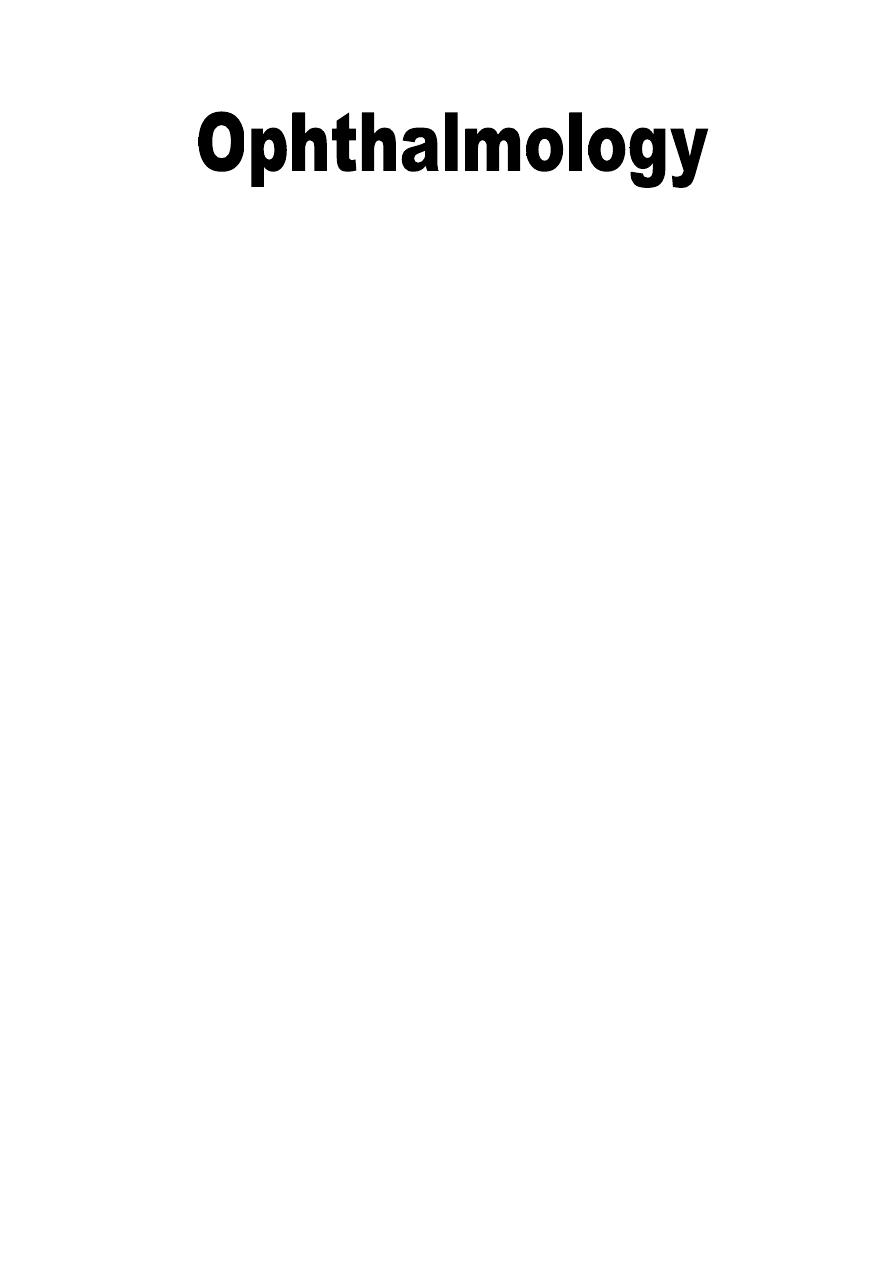
1
Lecture 11
Dr. Najah
طب بغداد
2015
-
6
102
Uveitis
Anatomy of Uveal tract:
The middle layer of the eye, the uva (uveal tract), is composed of three regions (from
front to back): the iris, ciliary body, and choroid. The uvea sometimes is called the
vascular layer because its largest structure, the choroid, is composed mainly of blood
vessels, which supply the outer retinal layers.
The iris is a thin, circular structure located anterior to the lens, often compared with a
diaphragm of an optical system. The center aperture, the pupil, actually is located
slightly nasal and inferior to the iris center. Pupil size regulates retinal illumination.
The diameter can vary from 1 mm to 9 mm depending on lighting conditions. The
pupil is very small (miotic) in brightly light conditions and fairly large (mydriatic) in
dim illumination.
The sphincter muscle lies within the stroma and is composed of smooth-muscle cells
joined by tight junctions.
As its name implies, the sphincter is a circular muscle 0.75
to 1 mm wide, encircling the pupil and located in the pupillary zone of the stroma.
The sphincter muscle is anchored firmly to adjacent stroma and retains its function
even if severed radially.
Contraction of the sphincter causes the pupil to constrict in
miosis. The muscle is innervated by the parasympathetic system.
The dilator muscle is present from the iris root to a point in the stroma below the
midpoint of the sphincter. Because the fibers are arranged radially, contraction of the
dilator muscle pulls the pupillary portion toward the root, thereby enlarging the pupil
in mydriasis. The dilator is sympathetically innervated.
The ciliary body is a ring-shaped structure. Its width is approximately 5.9 mm on the
nasal side and 6.7 mm on the temporal side.
The ciliary body can be divided into two
parts: the pars plicata and the pars plana . The pars plicata is the wider, anterior
portion containing the ciliary processes. Approximately 70 to 80 ciliary processes
extend into the posterior chamber, and the regions between them are called valleys of
Kuhnt. The ciliary muscle is composed of smooth muscle fibers oriented in
longitudinal, radial, and circular directions. Interweaving occurs between fiber
bundles and from layer to layer, such that various amounts of connective tissue
are found among the muscle bundles.
The choroid extends from the ora serrata to the optic nerve and is located between the
sclera and the retina, providing nutrients to outer retinal layers. It consists primarily
of blood vessels. However, a thin connective tissue layer lies on each side of the
stromal vessel layer.

2
Definition of Uveitis: it is an inflammation of the uveal tract (Iris, Ciliary body
and choroid) and adjacent structures, most probably the retina.
Classification: - Anatomical.
- Clinical.
- Aetiological.
Anatomical Classification:
1- Anterior uveitis: which is subdivided into:
a- Iritis: in which inflammation predominantly affects the iris.
b- Iridocyclitis: in which both the iris and anterior part of the ciliary body
(pars plicata) are equally involved.
If the number inflammatory cells was equal in both the aqueous and vitreous,
it is iridocyclitis, while if the number was larger in aqueous, it is iritis.
2- Intermediate uveitis:
It is characterized by involvement predominantly of the posterior part of the
ciliary body (pars plana), periphery of the retina and the underlying periphery
of the choroid.
3- Posterior uveitis:
Inflammation of the choroid and retina posterior to the equator of the eye.
4- Panuveitis:
Involvement of the entire uveal tract.
Clinical classification:
1- Acute uveitis: usually has a sudden, symptomatic onset and persists for up
to 3 months. If the inflammation recurs following the initial attack it is referred
as recurrent acute uveitis.
2- Chronic uveitis: the onset is frequently insidious and may be
asymptomatic. It usually persists for longer than 3 months. Acute or subacute
exacerbations on chronic may occur.
Aetiological classification:
1- Idiopathic: which forms more than 50% of cases of uveitis.
2- Associated with a systemic disease, e.g.:
a- Spondyloarthopathies: ankylosing spodylitis, Reiter's syndrome, psoriatic
arthritis and chronic juvenile arthritis.
b- Inflammatory bowel disease: ulcerative colitis, Crohn's disease,
Whipple's disease.
c- Nephritis.
d- Non-infectious multi-system disease: sarcoidosis, Behçet's disease.
e- Infectious systemic disease: e.g. TB, syphilis
f- Diabetes.

3
3- Infections:
a- Bacterial: tuberculosis.
b- Fungal: Candidiasis.
c- Viral: Herpes Zoster.
4- Infestations:
a- Protozoa: Toxoplasmosis.
b- Nematodes: Toxocariasis.
Anterior uveitis
Symptoms:
1- Acute anterior uveitis: Photophobia, pain, redness, decreased visual acuity
and lacrimation.
In acute anterior Uveitis, the pain is due to spasm of ciliary muscle, and
decrease visual acuity is due to turbidity of aqueous by inflammatory cells,
leakage of proteins which are present due to break down of blood-aqueous
barrier. There may be normal or increased IOP (if the angle are closed by
cells and proteins), but more commonly is decreased IOP or hypotony due
to ciliary shutdown.
2- Chronic anterior uveitis: may be asymptomatic or give rise to mild
redness and the perception of floaters.
Signs:
1- Circumcorneal injection: acute anterior uveitis has a violaceous hue.
2- Keratic precipitates: deposition of inflammatory cells into corneal
endothelium.
Their characteristics and distribution may indicate the probable cause of
uveitis.
3- Cells: indicative of acute inflammation: it is graded from grad 1 to grad 4
according to the number of these cells.
a- Aqueous cells.
b- Anterior vitreous cells.
4- Aqueous flare: is seen due to scattering of light by proteins that have
leaked into aqueous humour by break down of blood-aqueous barrier. It is
graded from 1 to 4 according to its haziness or obscuration to the details of
iris.
5- Iris nodule: which is a feature of chronic granulomatous inflammation.
Complications of anterior uveitis:
1- Posterior synechiae: 360° (seclusio pupillae) causes iris bombé that leads
to closure of the angle of anterior chamber and ends with secondary angle
closure glaucoma.
2- Cataract.
3- Glaucoma: inflammatory or secondary angle closure glaucoma.
4- Cyclitic membrane formation which leads to traction and then detachment
of the Ciliary body which causing phthisis bulbi.

4
Intermediate Uveitis
Symptoms:
Initially, floaters (inflammatory cells in anterior vitreous) and later,
decreased visual acuity due to macular edema (due to associated vitritis).
Signs:
Cellular infiltration of vitreous (vitritis).
Complications:
1- Cystoid macular oedema if there is chronic macular edema.
2- Cyclitic membrane and phthisis bulbi.
3- Cataract.
4- Tractional retinal detachment duo to vitreous gliosis and fibrosis.
Posterior uveitis
Symptoms:
1- Floaters (due to cells and flare in the vitreous).
2- Impairment of visual acuity (due to macular oedema).
Signs:
1- Cells, flare, opacities and posterior vitreous detachment: inflammatory
process of vitreous (vitritis) leads to its shrinkage and then separation of
posterior vitreous face from the retina (posterior vitreous detachment).
2- Retinitis: ill-defined, focal, white, cloudy appearance of retina with
obscuration of retinal vessels.
3- Vsculitis: acute vasculitis, which is characterized by a fluffy white haziness
surrounding the blood column.
Complications:
1- Cystoid macular oedema.
2- Macular ischaemia.
3- Epiretinal membrane formation.
4- Vascular occlusion.
5- Retinal detachment (exudative or tractional).
6- Consecutive optic neuropathy (due to ischaemia that affects the ganglion
cells layer, nerve fiber layer and the optic disc itself).
Special investigations for patients with uveitis:
1- X-Ray:
- Sacroiliac joint (for ankylosing spondylitis).
- Chest x-ray (for TB and sarcoidosis).
- Skull calcification: toxoplasmosis.
2- Skin test: histoplasmosis, Mantoux and kveim (sarcoidosis).
3- Serum tests: ANA (Anti-Nuclear Antibodies) as in chronic juvenile
arthritis, VDRL, toxoplasmosis test (IFAT) and ELISA.
4- HLA-typing: HLA-B27 for ankylosing spondylitis and B5, B51 for
Behçet's disease.

5
Treatment:
1- Mydriatics and cycloplegics:
Short acting: Tropicamide 0.5% (for <1y) & 1% (for > 1y), the duration of
action is 6 hours.
Cyclopentolate 0.5% (for <1y) & 1% (for > 1y), the duration
of is 24 hours.
* Both of previous drugs have mydriatic and cycloplegic effects
by inhibiting the sphincter muscles of the iris and inhibition of
Ciliary body muscles through its parasympatholytic action.
Phenylnephrine (sympathetic agonist) 2.5% (up to 16y) &
5%, 10% (adult), the duration of action is 6 hours, but has no
cycloplegic effect. It causes dilatation of the pupil by
stimulation of radial muscles of the iris (sympathomimetic
action). Cautious should be taken when using this drug, as it
elevates blood pressure and causes tachycardia.
Long acting: Atropine 0.5% (for <1y) & 1% (for > 1y), it is the most
powerful cycloplegic and mydriatic, its duration of action is 2
weeks.
Advantages of using mydriatic and cycloplegic drugs:
a- To promote comfort through muscles paralysis (except phenynephrine).
b- To prevent formation of posterior synechiae through continuous movement
of the pupil and getting the pupillary margin away from convexity of lens
center. (including phenynephrine)
c- To break down recently formed synechiae.
d- stabilize blood aqueous barrier and decrease inflammation specially
atropine.
2- Steroids:
-Topical steroids: only for anterior uveitis, because they do not reach
therapeutic levels behind the lens.
Potent steroids are: prednisolone acetate, Dexamethasone and betamethasone.
Side effects of topical steroids (especially after prolonged use):
a- Rising IOP and Glaucoma.
b- Cataract.
c- Corneal complications: they are rare, e.g. bacterial and fungal keratitis and
recurrence of herpes simplex keratitis.
d- Systemic side effects.
-Periocular injection of steroids(sub Tenon's)
Indications:
a- Severe acute anterior uveitis.
b- As an adjunct to topical or systemic steroid in resistant cases.
c- Intermediate uveitis.

6
d- posterior uveitis.
e- Poor patient compliance with topical or systemic steroids.
-Intravitreal injection of steroids:
Injection of triamcinolone acetonide (2mg in 0.05ml) in resistant uveitic
chronic cystoid macular oedema. Increase IOP is common side effect of
intravitreal injection of steroid.
-Systemic steroids:
Either orally: prednisolone tablets
Or as injections: Adrenocorticotrophin hormone (ACTH) if the patient is
intolerant to oral steroids.
Indications:
a- Intractable anterior uveitis resistant to topical and periocular steroids.
b- Intermediate uveitis unresponsive to preiocular injection.
c- Posterior ueveitis or panuveitis, particularly with severe bilateral
involvement.
3- Immunosuppressive agents:
Either Antimetabolites (cytotoxic) as Azathioprine and Methotrexate, Or T-
cell inhibitors as ciclosporin A.
Indications:
a- Sight (vision)-threatening uveitis:
Which is usually bilateral, non-infectious and has failed to response to
adequate steroid therapy.
b- in patients with intolerable side effect from systemic steroids.
1, 2 and 3 are used to treat cases with undetected etiology (idiopathic).
But if we find a cause, so the treatment is by 1, 2, 3 in addition to:4
4- Treatment of underling cause.
e.g. TB, syphilis, toxoplasmosis, toxocariasis, ect.



